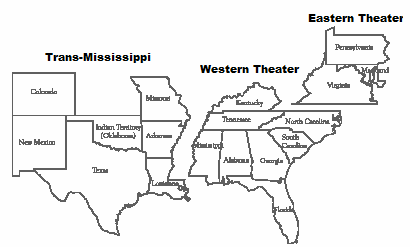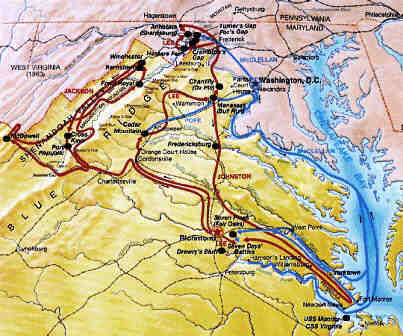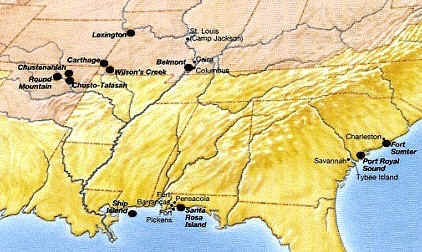| Theaters of the Civil War |
|
| Theaters of the Civil War
There were three Theaters of the Civil War, a phrase that describes the areas where the major battles of the Civil War took place. The military operations of the Civil War were conducted in the Eastern, Western and Trans-Mississippi theaters of war. Theaters of War are the areas of land, and water that is, or may become, directly involved in the military battles and conduct of the war. Theaters of the Civil War
Abraham Lincoln was the 16th American President who served in office from March 4, 1861 to April 15, 1865. This article provides facts and information about the major Theaters of the Civil War. |
|
Three Theaters of the Civil War
The Civil War Map defines the areas between the Western Theater, the Eastern Theatre and the Trans-Mississippi Theater of War. The majority of the battles of the Civil War were fought in Virginia in the Eastern Theater. The greatest number of battles, including skirmishes and small conflicts by states, were as follows: Virginia: 2,154
Tennessee: 1,462
Missouri: 1,162
Mississippi: 772
Arkansas: 771 For additional information about military Strategy of the Union refer to details of Union Blockade and the Anaconda Plan | 
The Three Theaters of the Civil War Map
|
| | | Theaters of the Civil War
The Theaters of the Civil War were divided into principal theaters in which the major military operations took place: The Eastern Theater that comprised of the area east of the Appalachians in the locality of the rival capitals of Washington and Richmond The Western Theater that comprised of the area west of the Appalachians and east of the Mississippi River The Trans-Mississippi area included Missouri, Arkansas and Louisiana and other lands to the west
Minor military operations that took place along the coasts and inland waterways and the more isolated areas. In addition to the land based Theaters of the Civil War, there were Naval battles on the high seas fought between cruisers, privateers and the Blockade Runners |
| | Theaters of the Civil War - Eastern Theater Map 
| Theaters of the Civil War - The Eastern Theater
The Eastern Theater comprised of the area east of the Appalachians in the locality of the rival capitals of Washington of the Union and Richmond of the Confederacy. The Eastern Theater of the Civil War included the states of Virginia, West Virginia, Pennsylvania, Maryland, the District of Columbia, and the seaports of North Carolina The Eastern Theater of the Civil War was important because not only did it include the capitals it also covered densely populated and highly industrial regions The two major armies that fought in the Eastern Theater were the Union Army of the Potomac and the Confederate Army of Northern Virginia Generals who led the armies in the Eastern Theater of the Civil War were Grant, Sherman, and Sheridan for the North and Lee, Jackson, and Longstreet for the South. The major battles fought in the Eastern Theater of the Civil War included the Battle of Bull Run at Manassas, the Battle of Antietam, and the great Battle of Gettysburg.
|
| | Theaters of the Civil War - The Western Theater
The Western Theater of the Civil War comprised of the area west of the Appalachians and east of the Mississippi River. The Western Theater of the Civil War primarily took place in the states of Tennessee, Mississippi and Georgia The major battles fought in the Western Theater of the Civil War included the Battle of Shiloh, the Battle of New Orleans, the Battle of Stones River, Battle of Chickamauga and the Battle of Vicksburg. Generals who led the armies in the Western Theater of the Civil War Grant, Halleck, Sherman, Buell, and Rosecrans for the North and Johnston, P.G.T. Beauregard, and Braxton Bragg for the South.
| Theaters of the Civil War - the Western Theater Map 
|
| | | 
| Theaters of the Civil War:
Trans-Mississippi theater of war The Trans-Mississippi theater of the Civil war covered everything from the Mississippi River west to the Pacific Ocean. The Trans-Mississippi Theater of the Civil War took place in the states of Missouri, Kansas, Arkansas, the Indian Territory (Oklahoma), Louisiana, and Texas. The major battles fought in the Trans-Mississippi Theater of the Civil War included the battles of Pea Ridge, Prairie Grove, Westport and Wilsonís Creek Over 200,000 men were engaged in the Trans-Mississippi theater of war
|
|
Theaters of the Civil War: Trans-Mississippi theater of war - The South is split in two
The Trans-Mississippi theater of the Civil war generally receives the least attention but it was extremely important. The Union forces split the Confederacy by taking control of the Mississippi River, which served as a natural divide, with the Confederate States of Missouri, Arkansas, Louisiana and Texas t o the Southern states west of the river. Control of the Mississippi River divide the far western states allowed the passage of Union gunboats. The Union took complete control of the Mississippi River, and divided the South in two by the capture of Vicksburg, Mississippi on July 4, 1863 and the capitulation of Port Hudson, Louisiana on July 9, 1863. Theaters of the Civil War - President Abraham Lincoln Video
The article on the Theaters of the Civil War provides an overview of the war that divided the nation. The following Abraham Lincoln video will give you additional important facts and dates about the political events experienced by the 16th American President whose presidency spanned from March 4, 1861 to April 15, 1865. | | |
| |
|